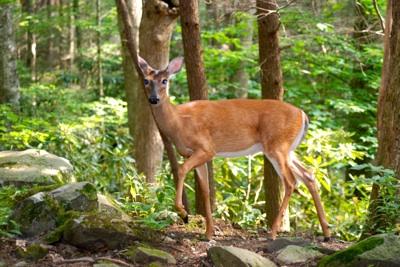National park visitors hoping to spot wildlife in the parks this fall might encounter a disturbing sight: hunters toting their kills through the parks.
While hunting long has served a valuable role both in managing wildlife and getting young and old outdoors, it long has been prohibited in national parks. While hunting still is banned in most units of the National Park System (some preserves allow hunting), the congressionally ordered change in gun regulations adopted earlier this year means hunters can travel through parks to reach bordering lands where they can hunt.
And in the case of the Blue Ridge Parkway and Yellowstone National Park, just to name two park units, they can even gain permission to bring their kills through the park.
Blue Ridge Parkway officials put this announcement out the other day:
"Accessing game lands adjacent to the Blue Ridge Parkway no longer requires a permit; however, you must contact the park prior to transporting game," says Steve Stinnett, chief ranger for the Blue Ridge Parkway. The federal government changed the laws for carrying firearms in national park units to be consistent with state laws, effective February 10, 2010. In Virginia and North Carolina, that means concealed carry of handguns with a valid permit and open carry of legal firearms are allowed. "Hunting on parkway lands, the use and discharge of firearms, carrying firearms in federal facilities, and the possession of other weapons and traps are still prohibited," said Stinnett.
The end of the permit removes the need to track down a ranger or travel to a parkway office to obtain a permit. This change also means that permission which was previously given for transporting game across park lands and roads is gone. "Under the new procedure, anyone taking game is directed to transport it in a way that does not cross park lands or use the Parkway," said Stinnett. "If the parkway is the only reasonable access for removal of game, hunters must request permission by contacting a park ranger or the Communications Center (828-298-2491, 24 hrs/day) prior to the transport. It is the hunter's responsibility to show that the game was not taken on park lands, and transport is limited to the closest state road access to the parkway."
In Yellowstone, officials put out a statement alerting hunters that it's their responsibility to know where the park's boundaries are. Additionally, hunters are not allowed to pursue game into the park, even if they shot it on adjoining lands and the animal fled into Yellowstone.
The Lacey Act and the Code of Federal Regulations strictly prohibit the killing or removal of any animal, living or dead, from inside Yellowstone. This includes animals legally shot outside the park which then cross into and die within the park boundary. Taking and removing any animal parts, including shed antlers, is also prohibited.
Yellowstone officials also note that hunters are prohibited from transporting through the park "heads and spinal cords of deer, elk, or moose which were taken in states known to have chronic wasting disease in wildlife."
That said, "game animal carcasses or parts may be transported through Yellowstone by motor vehicle on park roads only if they are covered or stored out of sight, accompanied by a transport permit from the National Park Service, and are bearing a valid state tag as evidence that the animal was taken legally outside of the park," the officials said.
Transport permits must be secured before entering the park, and can be obtained at any park entrance station or by calling (307) 344-7381, and arranging to meet with a ranger.
Game animals cannot be transported on backcountry trails or stored overnight anywhere in the park, including campgrounds, parking lots, or at concession facilities. Stock users are reminded that proof of a current, negative Coggins test is required for all horses and mules being transported into or through the park.
Visitors or hunters who observe illegal hunting activity within the park should call the NPS tip line at (307) 344-2132. In some cases a cash reward is offered for information leading to the arrest and conviction of anyone illegally using firearms in the park or illegally killing or transporting wildlife in the park.


 Support Essential Coverage of Essential Places
Support Essential Coverage of Essential Places







Comments
Why would seeing a hunter be a disturbing sight?
Some people are funny that way. Although, most visitors with children should be gone, since they are probably back in school. And, a hunter with meat to pack out will probably have it quartered up in a pack. So, it shouldn't be an issue, unless someone chose to make it one.
Anonymous wrote,
"Why would seeing a hunter be a disturbing sight?"
It's not the hunters per se. Take another look at what the post actually says: "hunters toting their kills through the parks."
I go to the parks to see wildLIFE, not their corpses.
BAD MOVE, for one thing it is inredibly dangerous and for another thing, seeing "The KILL" or as some people call them "Trophy's" is very disturbing to some, especially children. This is NOT the way I want the children of the world to experience our beautiful National Parks.
Nothing says "Mother Nature" like a bloody corpse on the hood of a pickup truck.
Maybe they should have phrased it hunters toting there food through the park
The euphemism of "food" obviously doesn't change the image.
I find it odd how so many people are appalled at the sight of a hunter with whatever animal it is that he has taken in the back of his truck. Then sit at home and watch a pack of wolves or lions on the discovery channel take down and eat some animal while its still alive, usually starting at the hind quarters first, while it balls and its eyes roll back in its head then slowly dieing while its being consumed. Whatever.